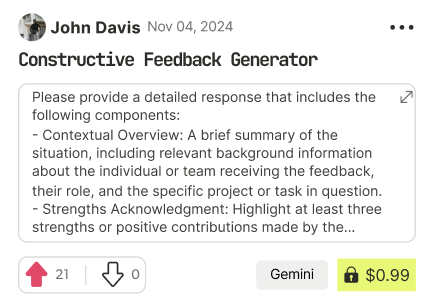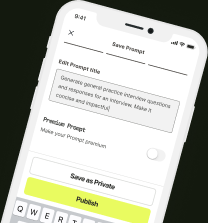prompt mine App
Find, Create & Share AI Magic
Unlock the Fun: Creating a DIY Escape Room at Home
## DIY Escape Room: Your Step-by-Step Guide to Creating a Thrilling Adventure at Home!
This guide will help you design and execute your own escape room experience at home, providing a fun and engaging activity for friends and family.
**Phase 1: Laying the Groundwork**
**Step 1: Theme Selection - The Foundation of Your Escape Room**
A strong theme is crucial for immersion and puzzle integration. Here are three unique themes suitable for home replication:
* **Theme 1: The Mad Scientist's Lab:** You're trapped in the lab of a quirky, absent-minded scientist who's gone missing. You need to decipher his notes, experiment logs, and contraptions to figure out how to escape before his latest experiment goes haywire.
* **Atmosphere:** Messy workspace, beakers, test tubes, bubbling concoctions (using food coloring and baking soda), scientific diagrams, and warning signs.
* **Theme 2: The Lost Pirate Treasure:** You and your crew have stumbled upon the hidden cabin of a legendary pirate. To claim his treasure, you must solve the riddles and puzzles he left behind, leading you to the map and the hidden booty.
* **Atmosphere:** Treasure chest, nautical maps, skulls, compasses, ropes, pirate flags, old bottles, and dimmed lighting.
* **Theme 3: The Time Traveler's Study:** A time traveler has vanished, leaving behind clues to their next destination. You must solve the chronological chaos to determine when and where they went, unlocking the portal (the exit) to bring them back.
* **Atmosphere:** Old books, antique clocks, maps of different eras, historical artifacts (replicas), travel journals, a chalkboard with timelines, and a world globe.
**Step 2: Puzzle Creation - The Heart of the Challenge**
Here are tips for crafting engaging and challenging puzzles:
1. **Mix Puzzle Types:** Combine different puzzle styles to cater to diverse problem-solving skills. Include:
* **Physical Puzzles:** Jigsaw puzzles (modified for a specific clue), lockboxes requiring keys or combinations, tangram puzzles, objects hidden within other objects.
* **Riddles and Wordplay:** Cryptograms, anagrams, word searches, logic puzzles, riddles that connect to the theme.
* **Cipher Puzzles:** Simple substitution ciphers (A=1, B=2), Caesar ciphers (shifting letters), using online cipher generators.
* **Observation Puzzles:** Hidden objects in plain sight, subtle alterations in pictures, discrepancies between objects or arrangements.
* **Math Puzzles:** Simple calculations using clues found in the room, sequence recognition (e.g., Fibonacci sequence).
2. **Theme Integration:** Each puzzle should feel like a natural part of the theme. For the "Mad Scientist" theme, use chemical formulas or lab equipment; for the "Pirate Treasure" theme, use nautical charts or pirate lore.
3. **Progressive Difficulty:** Start with easier puzzles to build confidence and then gradually increase the complexity. The initial puzzles should reveal clues that lead to the harder ones.
4. **Multi-Step Puzzles:** Create puzzles that require multiple steps to solve. For example, solving a riddle reveals a number combination, which then unlocks a lockbox containing another clue.
5. **Utilize Household Items:** Don't overspend! Use everyday items creatively: books, furniture, containers, toys, paper, pens, flashlights, etc.
6. **Misdirection is Key:** Incorporate red herrings (false clues) to add an extra layer of challenge. Make some items seem important but lead nowhere.
7. **Tailor to Your Players:** Consider the age and experience of your players when designing the puzzles. Adjust the difficulty level accordingly.
**Example Puzzles:**
* **Mad Scientist:** A cipher written in a scientific notation code needs to be deciphered using a key found in a lab notebook.
* **Pirate Treasure:** A tattered map with missing pieces (jigsaw puzzle) reveals the location of the next clue once assembled.
* **Time Traveler:** A series of historical events are listed out of order. The correct chronological order unlocks a code using the corresponding dates.
**Phase 2: Setting the Stage**
**Step 3: Room Layout and Decoration - Creating the Immersive Experience**
1. **Choose Your Room:** Select a room in your house that you can temporarily dedicate to the escape room. Living rooms, bedrooms, or spare rooms work well.
2. **Transform the Space:** Decorate the room to match your chosen theme. Use readily available items and online resources (printable posters, thematic images).
* **Mad Scientist:** White lab coats, goggles, beakers, test tubes, scientific diagrams, "caution" tape.
* **Pirate Treasure:** Ropes, treasure chests, nautical maps, skull decorations, dim lighting.
* **Time Traveler:** Old books, maps, antique clocks, historical artifacts, travel journals.
3. **Room Flow:** Plan the layout to create a logical flow for the players. Guide them through different areas of the room as they solve the puzzles.
**Step 4: Concealing Clues and Puzzles - The Art of Hidden Deception**
1. **Think Creatively:** Hide clues in unexpected places:
* Inside books (use a bookmark to mark the page).
* Under furniture.
* Behind picture frames.
* Inside containers.
* Taped to the underside of drawers.
* Rolled up and placed inside a hollow object.
2. **Camouflage:** Make clues blend in with their surroundings. Use aged paper for the "Pirate Treasure" theme or scientific jargon for the "Mad Scientist" theme.
3. **Use Multiple Layers:** Hide clues within other clues. A hidden message reveals the location of a lockbox, which contains the final piece of the puzzle.
4. **Marking Important Items:** Use subtle markings (e.g., a pen mark on a specific book, a small sticker on a significant object) to draw attention to crucial elements.
**Step 5: Timing and Pacing - Creating the Excitement**
1. **Set a Time Limit:** A typical escape room lasts 60 minutes. Use a timer or a countdown clock to create a sense of urgency.
2. **Introduce Clues Strategically:** Don't reveal all the clues at once. Introduce them gradually as the players progress through the puzzles.
3. **The Hint System:** Prepare hints for each puzzle. Decide how many hints you'll provide and how players can request them (e.g., after a certain amount of time has passed).
4. **Monitor Progress:** As the "Gamemaster," observe the players' progress and provide guidance if needed. This can be done remotely using a hidden camera or by discreetly checking in on the players.
5. **Victory and Aftermath:** Celebrate the players' success (or commiserate their near-success). Provide a small reward or certificate for completing the escape room.
**Final Checklist:**
* Have you tested all the puzzles yourself to ensure they are solvable?
* Are all the clues hidden securely?
* Is the timer set and ready to go?
* Do you have a hint system in place?
* Is the room decorated to create an immersive experience?
* Have you informed all players about the rules and objective of the escape room?
**Important Considerations:**
* **Safety First:** Ensure the escape room is safe for the players. Remove any potential hazards.
* **Accessibility:** Consider any physical limitations of the players and adjust the puzzles accordingly.
* **Have Fun!** The most important thing is to create a fun and memorable experience for everyone involved.
By following this guide, you can create a thrilling and engaging DIY escape room at home that will challenge and entertain your friends and family! Good luck, and happy escaping!

Find Powerful AI Prompts
Discover, create, and customize prompts with different models, from ChatGPT to Gemini in seconds

Simple Yet Powerful
Start with an idea and use expert prompts to bring your vision to life!

